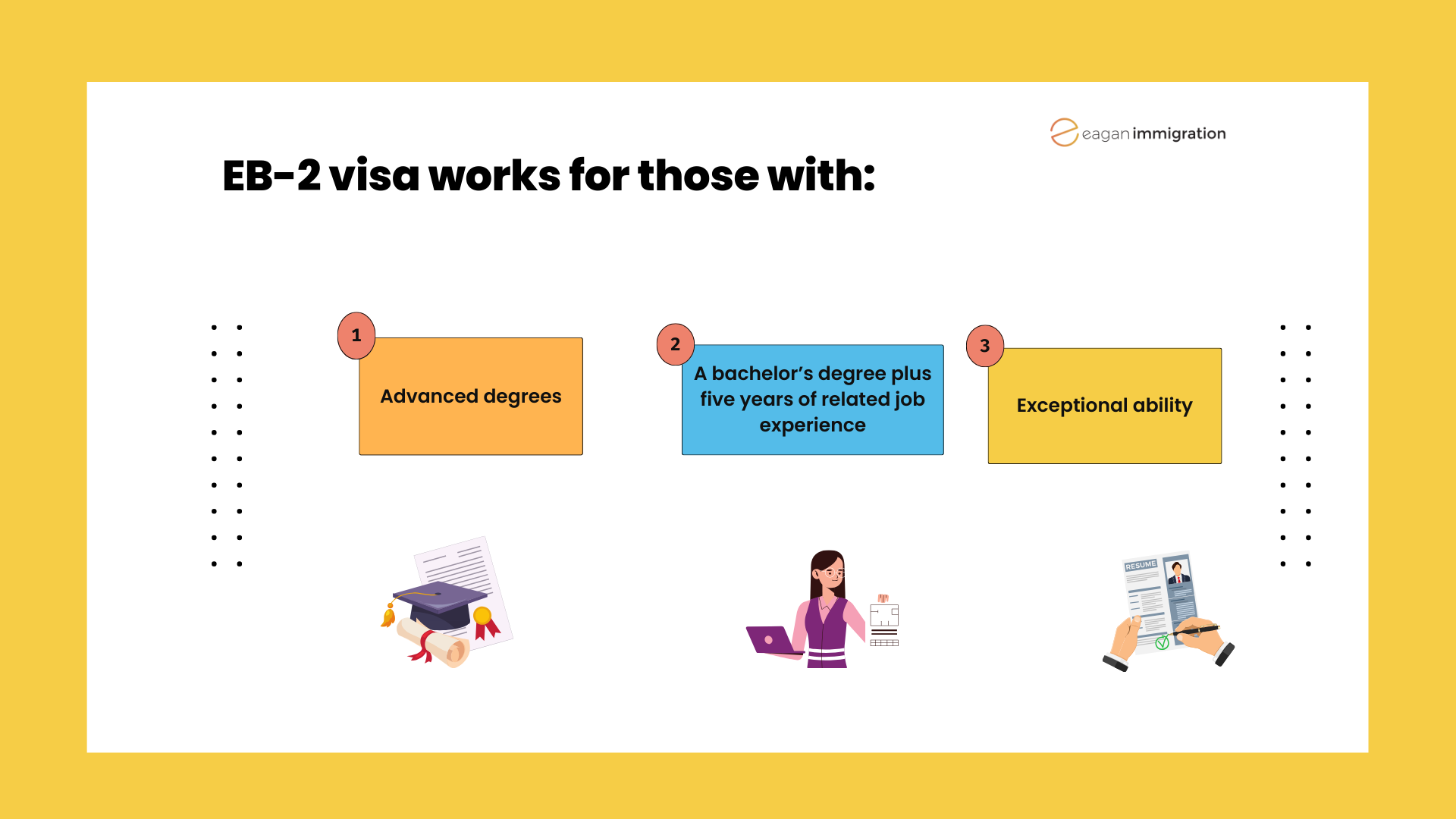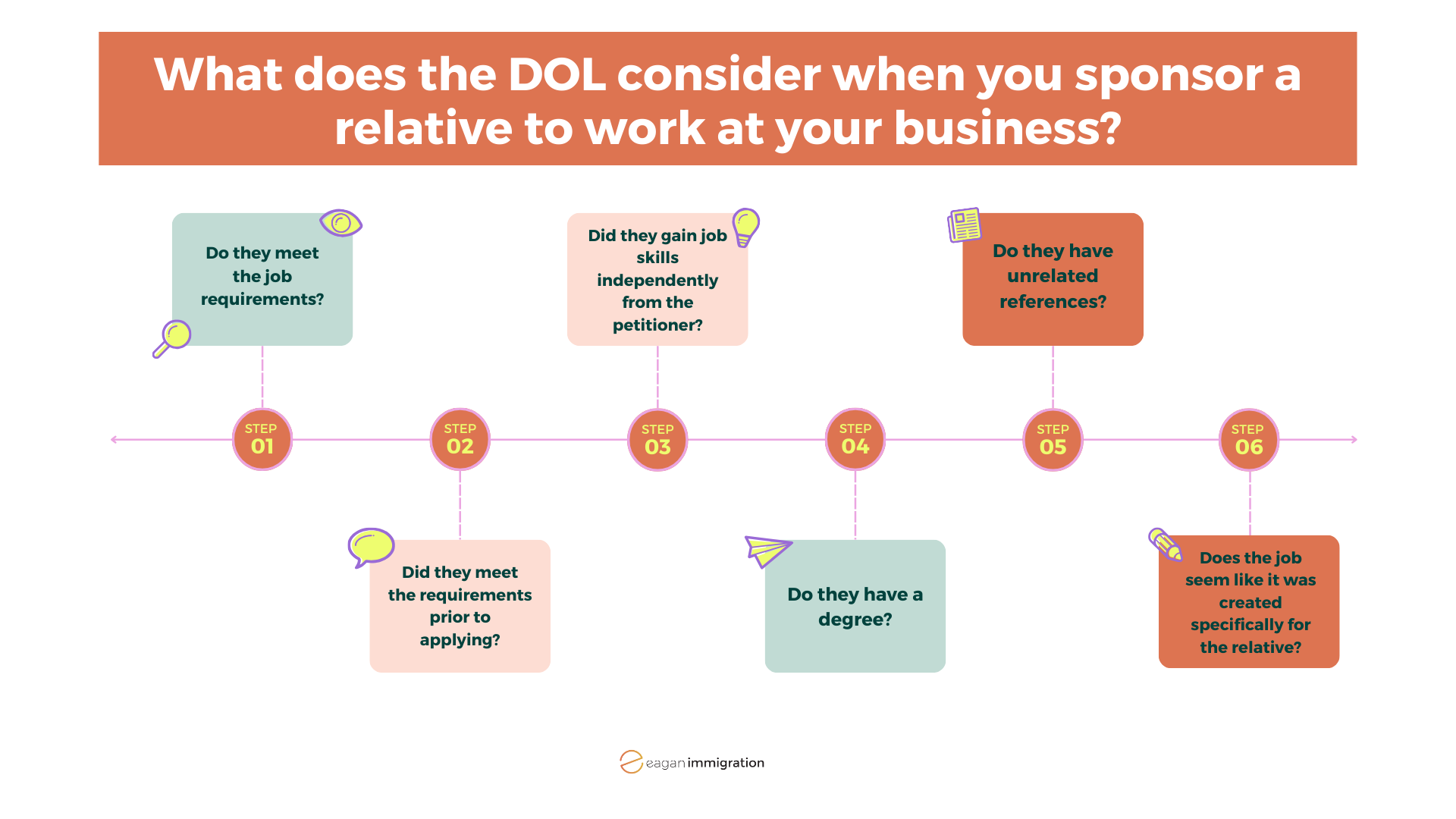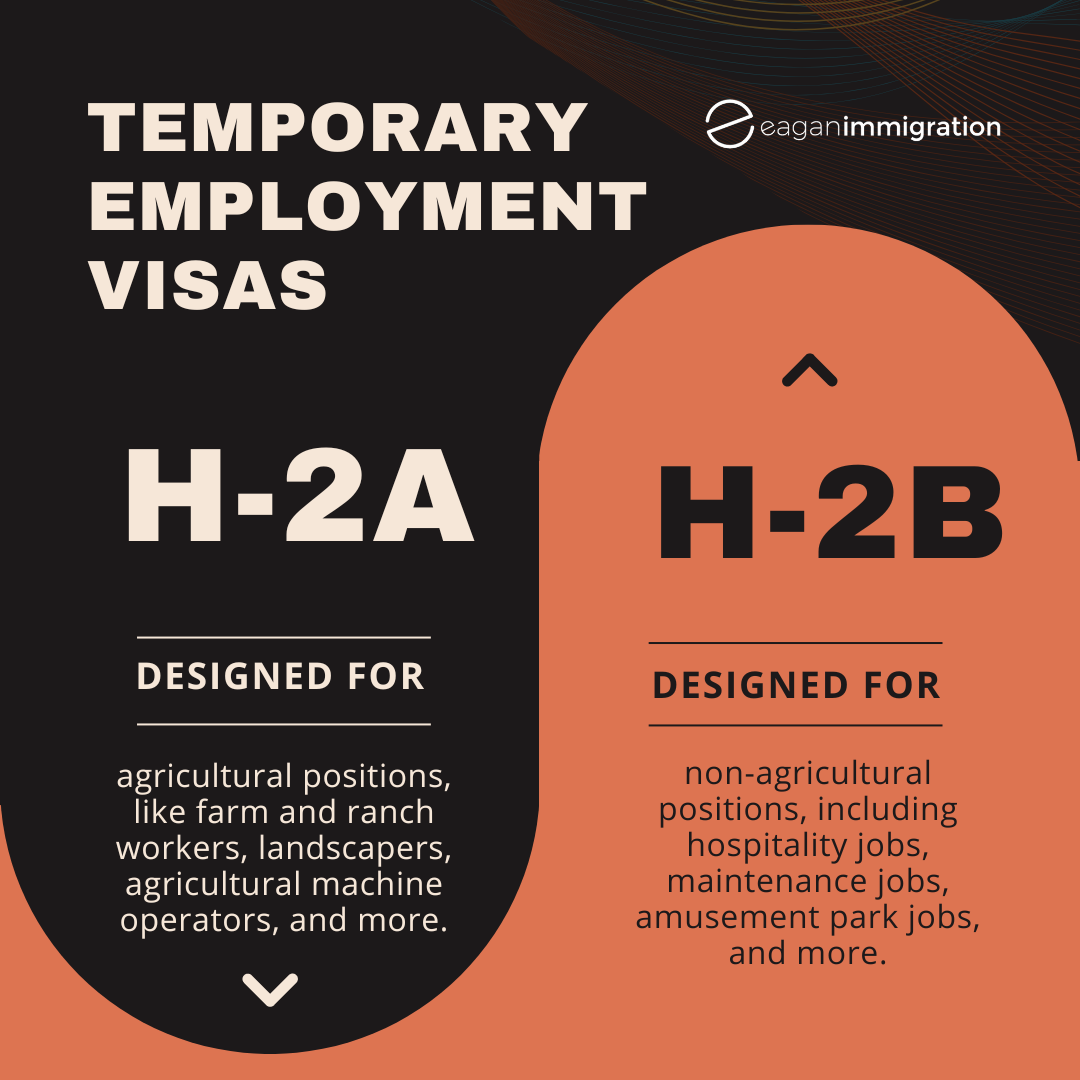How You Can Hire Your Family Members from Overseas to Work for Your U.S.-based Business
- Business Immigration
- News
By Natalie McQuilkin
Did you know that if you are a U.S. citizen or a lawful permanent resident (LPR) and own a U.S.-based business, you can sponsor your relatives to work at your business?
Although it sounds like a loophole to bypass the lengthy family-based petition processing times, it’s fully legal to sponsor family members to work for your business. U.S. citizens and LPR business owners across the country use this method to not only fill open positions at their business but to also bring their relatives to the United States.
In fact, U.S. Citizenship and Immigration Services (USCIS) does not limit which employment-based pathways and visas you can sponsor your family member with, meaning you can petition them for the H-1B visa, O-1 visa, L-1A visa, and more. In today’s post, we’re going to cover two common green card pathways (the EB-2 and EB-3) and two common temporary immigrant visas (the H-2A and H-2B), which Eagan’s senior business attorney, Hannah Whaley, discussed in her April webinar.
The EB-2 and EB-3 Green Card Pathways
The EB-2 and EB-3 pathways are the most common ways to sponsor family members because they are employment-based green cards, meaning they provide an immediate pathway for the beneficiary to receive a green card.
The EB-2 is designed to accommodate those with a master’s or doctorate degree, those with a bachelor’s degree plus five years of experience, or those with exceptional ability. To meet the exceptional ability prong, the applicant must be able to provide evidence for three of the following criteria:
- An official academic record that shows the beneficiary has a degree, diploma, certificate, or similar award from an educational institution
- Letters from current or former employers documenting at least 10 years of full-time employment
- Licensing or certification to practice a profession
- Proof that the beneficiary has commanded a higher salary than others in their field
- Membership in a professional association
- Recognition of achievements and/or contributions from peers, government entities, and professional or business organizations
One thing that is important to note is that the family member interested in applying for the open position at your company using the EB-2 pathway must meet the criteria for the EB-2 when you begin the PERM process, which we discuss later in this post.
While the EB-2 pathway is designed for those with an advanced degree or exceptional ability, the EB-3 accommodates skilled workers, professionals, and other workers.
- Skilled workers have at least two years of job experience, education, or training.
- Professionals have a bachelor’s degree or its foreign equivalent.
- Other workers, also known as “unskilled workers,” can have fewer than two years of job experience but must be able to demonstrate the ability to perform unskilled labor.

Because the EB-3 pathway accommodates a wide range of workers, many view this as a good option for sponsoring family members if their business has an open position that does not require experience or a degree.

The PERM Process
Both the EB-2 and EB-3 employment pathways require the employer to file a PERM Labor Certification. The PERM is essentially designed to let employers hire foreign workers while also ensuring there are no capable U.S. workers able, willing, qualified, or available to fill the open position. These standards are designed to ensure that employers do not purposefully choose foreign workers over U.S. workers. This process is also very important to the Department of Labor (DOL) and USCIS when examining those who hire foreign relatives.
Filing the PERM is a multi-step process:
- Identify the open position at your business. This must be a permanent, full-time position, and having the job title, responsibilities, and skills required for this position will be important throughout the PERM process. This position should not be specifically tailored to your relative’s skills because it could cause the DOL to believe that you created this position for your family member. The DOL wants to see that you have hired people for similar positions in the past to ensure that it is a true job offer.
- Determine the prevailing wage. The prevailing wage is essentially the average wage for U.S. workers in specific locations and jobs. If you hire a foreign worker, the prevailing wage ensures he or she is paid appropriately so it doesn’t negatively affect U.S. workers’ wages. To determine the prevailing wage, you’ll submit Form ETA-9141 (Application for Prevailing Wage Determination) to the National Prevailing Wage Center. This form will require you to provide information about the job title, responsibilities, and required education and experience. Soon after, you’ll receive the prevailing wage determination.
- Recruit workers. Once you have the prevailing wage, the next step in this process is recruiting workers to interview for the position. You must advertise the open position for about a month, but the type of advertisement required differs depending on what job is being offered. Our post on how to file a PERM breaks down the recruitment process further. During recruitment, it’s important that you genuinely interview candidates. You’ll have to provide documentation as to why certain candidates weren’t the right fit for the open position, so it’s important to be honest during this process. If you interview a candidate who is a better match for the job than your family member but still choose to hire your relative, the DOL will likely see this as a cause for denial.
- File the PERM labor certification. If you’ve determined that the best candidate for the job is your relative, it’s time to file the ETA Form 9089 (Application for Permanent Employment Certification) with the DOL. This form will require you to provide information about the job opportunity, the prevailing wage, and the foreign national candidate you’ve chosen to hire. During this process, you must notify the DOL that you have chosen to hire a relative. Justia explains that the DOL’s definition of family is “[broader] than you might expect and covers any relationship based on blood, marriage, or adoption. Thus, a cousin of any degree is considered a family member, as is any stepchild, stepparent, or in-law.” If you don’t identify the beneficiary as a family member, the DOL will deny the application.
Ver esta publicación en Instagram
Processing Times and Next Steps
As of May 2024, it’s taking the DOL between 397 and 477 days to process PERM applications. Although this may seem like a long time, it’s years shorter than family-based petitions. In fact, as of May 2024, it’s taking the National Service Centers as long as nine years to process some petitions for family members of U.S. citizens or LPRs.

After the PERM is approved, you will file the Form I-140 (Immigrant Petition for Alien Workers) with USCIS. As of May 2024, it’s taking the Nebraska Service Center 7 months to process the I-140 for EB-2 applications and 8.5 months for the Texas Service Center. As for EB-3 Form I-140 petitions, it’s taking between 7.5 and 9 months them to be processed at the Nebraska and Texas Service Centers.
Once the Form I-140 is approved, your relative can adjust his or her status. This process will differ depending on if they’re in the U.S. or if they’re living outside of the country. If they’re in the U.S., they will submit the Form I-485 (Application to Register Permanent Residence or Adjust Status), attend a biometrics appointment, and then receive their green card. If they’re outside of the U.S., they’ll file the DS-260 (Immigrant Visa Electronic Application), attend a biometrics appointment, attend a visa interview, and then receive their green card.
The H-2A and H-2B Visas
You can also sponsor relatives through the H-2A and H-2B visas. These visas are different from the EB-2 and EB-3 employment-based green cards in that they do not provide a pathway to receiving a green card. Instead, they allow the beneficiary to temporarily work in the United States. Because of that, they do not require a PERM labor certification and instead require a temporary labor certification, which we’ll touch on later.
The H-2A is a temporary or seasonal agricultural visa that accommodates farm and ranch workers, landscapers, agricultural machine operators, and more. The H-2B is a temporary visa for nonagricultural positions and includes hospitality jobs, maintenance positions, amusement park jobs, and more. Like the H-2A, the H-2B is a temporary visa. However, the job must fall under one of the following: seasonal need, intermittent need, peak-load need, or one-time occurrence. We discuss each of these types of temporary employment in our H-2B visa blog post.

The Temporary Labor Certification
The temporary labor certification is similar to the PERM labor certification in that it requires the employer to obtain the prevailing wage and engage in recruitment. Like we mentioned earlier, it’s important that you prove to the DOL and USCIS that the open position is not tailored to your relative’s skills and that you genuinely attempted to recruit U.S. workers. Now, let’s break down the full steps:
- Obtain the prevailing wage determination. Like with the PERM, you’ll submit information about the open job position to the National Prevailing Wage Center so you can determine the minimum wage to pay a foreign worker.
- Prepare a job order, statement of temporary need, and Form ETA-9142B (Application for Temporary Employment Certification). You’ll prepare these documents after you obtain the prevailing wage determine. The job order is a document highlighting the open position and its duties and required experience. The statement of temporary need is a document that requires you to identify how long you need someone to work at your business. Form ETA-9142B is the application for temporary employment and includes all the information about the open position, how long the applicant will be needed, and the prevailing wage determination.
- Send the prevailing wage determination, Form ETA-9142B, job order, and statement of temporary need to the DOL.
- Receive notice of acceptance and engage in recruitment. Once the DOL approves the aforementioned documents, it’s time to start recruitment. Just like with the PERM process, you must prove that no willing, capable, qualified, or available U.S. workers can do the open position.
- Submit recruitment report, wait for temporary labor certification, and submit Form I-129 (Petition for Nonimmigrant Worker) to USCIS.
What’s Next?
After you’ve completed the temporary labor certification process, if the relative you’ve chosen to hire is living in the U.S., you can request his or her status be changed to H-2B visa worker when filing the I-129. If your relative is living outside of the U.S. when you submit the Form I-129, he or she can apply for the H-2A or H-2B visa with the U.S. Department of State at his or her country’s U.S. Embassy or Consulate. Then they will have to attend a visa interview. Once he or she receives the H-2A or H-2B visa, he or she will be able to seek admission with U.S. Customs and Border Protection at a port of entry.
As of May 2024, it’s taking the California Service Center just 15 days to process the Form I-129 for H-2A visas. For the Form I-129 for H-2B visas, the California Service center is processing the Form I-129 for H-2B visas in one month, while the Vermont Service Center is processing them in two months, according to USCIS.

Despite it being fully legal for you to petition your family member to work for your business, it’s important to note that the DOL and USCSIS will look closely at employment-based sponsorships for family members. These organizations are aware that some petitioners might try to skirt around the criteria for certain employment-based green cards or visas to reduce processing times and get their relatives to the U.S. faster. Because of this, it’s imperative that if you’re interested in pursuing this path, you must be willing to fully comply with DOL and USCIS standards, provide a true job offer, put in a good-faith effort in the recruitment process, and be honest that you are hiring a family member if you do so.
The main takeaway here is that the DOL is looking for legitimacy in this process. They want evidence that your relative did not influence hiring decisions and that you did not specifically create a position for them. On top of that, they’ll want to know if your hired relative owns part or all of the company.
To minimize the DOL’s concerns, you should not only prove that the hired relative meets the requirements, but they also met the requirements prior to applying for the job and did not gain experience through you. Other good indicators are having a degree and unrelated references.
The processes for hiring your family members to work for your business can seem daunting and overwhelming. That’s why Eagan’s senior business attorney, Attorney Hannah Whaley, is here to help. Attorney Whaley can help streamline the process by guiding you through each step and ensure you’re answering all the questions the DOL and USCIS might have. Moreover, she’ll keep you updated on your case and provide helpful insight every step of the way.
If you’re interested in hiring your family members for your business, you can reach out to us today by calling our office at (202) 709-6439 or clicking this link.
References
Processing Times, U.S. Citizenship and Immigration Services, Processing Times (uscis.gov), (last visited: May 2, 2024).
Processing Times, U.S. Department of Labor, Processing Times | Flag.dol.gov, (last visited: May 2, 2024).
Employment-Based Green Cards Sponsored by Family Members, Justia, (Oct. 2023), Employment-Based Lawful Permanent Residence Sponsored by Family Members | Immigration Law Center | Justia, (last visited: May 2, 2024).
Webinar: How to Sponsor Family Member Through Your U.S. Business, Eagan Immigration, (Apr. 25, 2024), Webinar: How to Sponsor Family Members Through Your U.S. Business (youtube.com).


